The kitchen space is constantly experiencing a lot of different influences. This room is characterized by high humidity, high concentration of grease and dirt, temperature drops. Therefore, it is so important to fill it with elements resistant to such conditions - decoration, equipment, furniture, accessories that can withstand the aggressive onslaught of the listed factors and cleaning funds. The subject of this article will be such a popular element of kitchen decoration as skinals. It is used to protect the wall above the work area. This element has a lot of advantages, which we will discuss below. Many options for kitchen skins are presented in the photo, in order to clearly demonstrate the high decorativeness of these elements.
Content
- What is skinned
- Advantages and disadvantages
- Skinal materials
- Glass types
- Image subject
- Ways of drawing and paint
- Lakobel
- Stencil
- Lacomat
- Mirror
- Film
- Painting
- Photo printing
- Skinali with 3D-drawing
- Backlight options
- Base material
- Installation methods for skins
- Glue
- Fixing
- Correct size calculation
- For which interiors is suitable
- How to choose and order skinals for your kitchen
- Care and maintenance tips
- Conclusion
What is skinned
Skinali means sheathing. This word can define any sheets or panels intended for finishing walls, furniture or ceilings. Most often this definition is used for decorative glass panels, transparent or decorated with photo printing, but it also applies to panels made of wood, metal, MDF, PVC.
Most often skins act as decorative vertical surfaces, kitchen "Aprons" for finishing the wall above the work surface, inserts into the doors of sliding wardrobes or facades cabinet furniture.
Glass panels have a significant advantage over plastic and other skinning materials, as they are much more durable. They perfectly resist the onslaught of moisture, withstand the effects of aggressive cleaners. They can be decorated using different techniques - matting, staining, photo printing. An apron made from such a panel does not have seams, which are usually very difficult to clean and protect against fungus.

The apron is made of skinal with a thickness of 4 to 12 mm. The panel is mounted after the assembly of the kitchen set. Manufacturers use different types of glass as raw materials, and the “raw” type of material is considered the cheapest. With its help, glazing is usually performed in houses. The sheets are decorated with a foil glued from the side of the wall. Despite the low heat resistance of such a finish, aprons designed in this way look incredibly impressive.
Such a screen is not suitable for installation behind the hob, as it may crack from the heat.
The tempered glass version is more durable. When broken, it crumbles into small pieces with non-sharp safety edges. It is more expensive, but also much more reliable material.


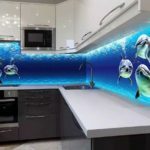


Advantages and disadvantages
Describing the significant characteristics of the skin, their pros and cons should be highlighted.
Advantages:
- Practicality. They do not absorb the aromas of the kitchen and do not contribute to the formation of mildew and mildew. Tempered glass is not easy to scratch or break.
- Safety. There is no release of toxins, therefore the material is not capable of provoking an allergic reaction and is characterized as completely harmless to humans.
- Easy maintenance. The surface is very easy to get rid of any kind of dirt. It cannot be spoiled by harsh chemicals.
- Fast and easy installation. Compared to the installation of tiles, the installation of skinals is carried out in record time. In a couple of hours, the wall will be fully formed.

The main and only drawback of a glass apron is the high cost of the product. The formation of this indicator is also greatly influenced by the method of glass decoration. For example, a screen designed using artistic painting can be simply prohibitively expensive.
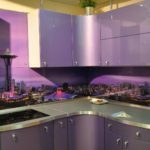




Skinal materials
The material for the apron should be selected taking into account the style, design and characteristics of the room.
- Tempered glass panels have sufficient strength and resistance to mechanical and temperature influences. Photo printing on such material is colorful, effective and durable.
- Plexiglass - acrylic and polycarbonate panels are also an excellent basis for photo printing. They are highly durable, but they can deform when heated. This option is suitable for kitchens with electric or induction cookers.
- Laminated MDF - a popular option. It is sufficiently resistant to moisture, does not swell, unlike ordinary wood.
- Chipboard laminated on both sides. Such products are very affordable, but not durable enough, since they are highly sensitive to moisture.
- Plywood with lamination of outer layers. The cover provides protection against moisture and condensation that forms between the wall and the screen. Usually the material is used for rustic or classic interiors in its natural form, and is rarely complemented by an image.
- PVC. Transparent products made of acrylic and polycarbonate lend themselves well to photo printing, are unable to absorb water, are hygienic, shock-resistant, do not form seams. They do not tolerate heating well - in close proximity to a hot stove they can melt. It is advisable to use such hobs in a kitchen equipped with an induction hob. The material is sensitive to abrasive agents, to acetone.
- Aluminum Composite Sheets - are a layered material with a thickness of 3-6 mm, consisting of two outer aluminum layers and a filler - mineral or plastic.



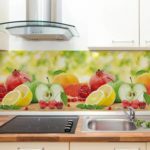

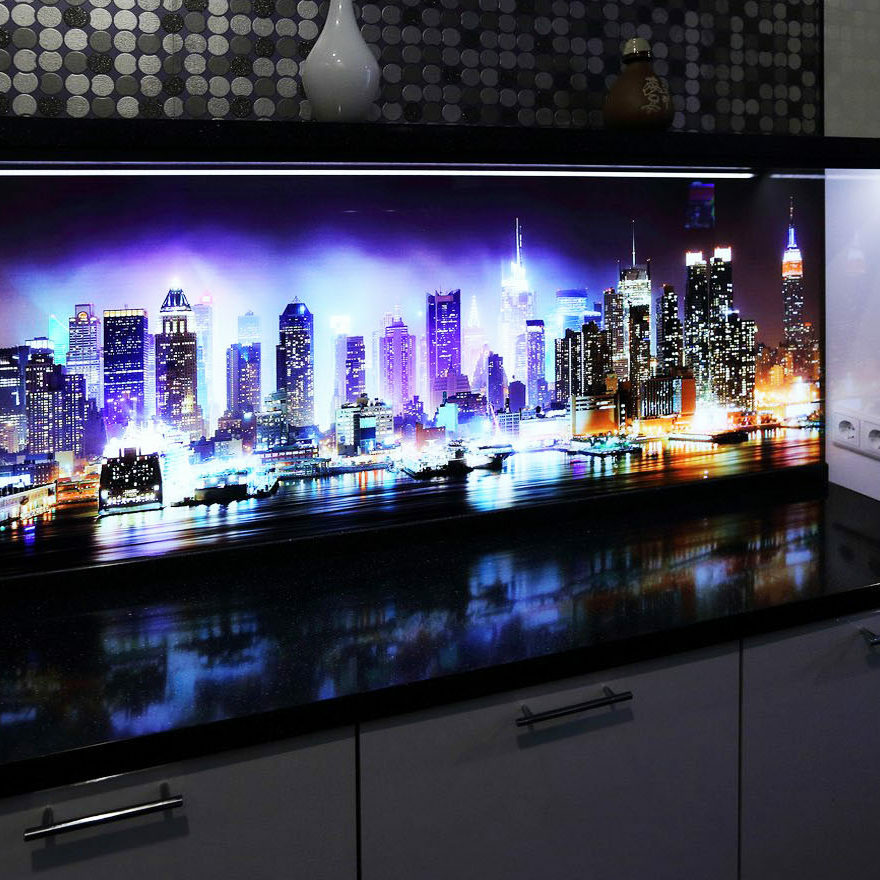
Glass types
Glass panels are the best option for creating a kitchen backsplash. But how not to be mistaken when choosing a material? Different types of glass have their own characteristics and have different characteristics.
For the manufacture of skinals can be used:
- ordinary glass - used for glazing windows and doors. The brightest pictures with a glossy surface are obtained on the surface of this material. It is considered the least durable among analogs. An apron made of such glass is not recommended to be installed behind a gas stove with an open fire. Leave a distance of 20-30 cm. Failure to comply with this requirement may lead to panel cracking;
- tempered glass or stalinite. During production, the material is subjected to heat treatment at high temperature conditions, alternating with sharp cooling. In the process, the glass is tempered, which provides it with high strength and refractory properties. Screens made of such material are not afraid of contact even with open fire. It is this very valuable property that increases the cost of manufactured products by an order of magnitude;
- triplex - high-strength version of glass, which is a kind of "sandwich". True, glass plays the role of bread here, and a special film acts as a "filling". The outer panels firmly "stick" to the interlayer, which, when broken, does not allow the fragments to crumble. Semi-transparent design on multiple layers of film allows you to create three-dimensional 3D-images. However, insufficient transparency does not allow getting rid of haze and slight blurring of the picture. The price tag for such skins is much higher than ordinary glass;
- plexiglass - affordable material with a democratic price. It is lightweight and flexible, which helps to reduce the complexity of installation. Low transparency reduces the brightness of the printed image. Plexiglas panels cannot boast of high strength and fire resistance.






Image subject
Most often, decorative design becomes the determining factor when choosing a skin. There are several of the most popular options for decorating kitchen aprons.
- Single color panels - are distinguished by their elegance and presentability. The lack of spectacular images is successfully leveled by the versatility and nobility of such products.
- Gradient - color transitions look very impressive, they allow you to combine contrasting tiers of headsets into a single composition.
- Ornaments, patterns, abstractions - discreet cyclical patterns - optimal design for a kitchen apron. Ornaments create an effective accent and attract attention. At the same time, they perfectly mask greasy splashes and other dirt. Abstractions fit perfectly into any modern interior and also distract attention from existing dirt.
Use geometric shapes if you want to adjust the shape of the room. Horizontal stripes can visually lengthen the wall, and vertical stripes can raise the ceiling.

- Natural motives - the most popular technique in the design of a kitchen apron. Depending on the preferences of the owner, the image of a forest at different times of the year, exotic jungle, sea with foam waves, desert, sky, shrubs and flowers can be chosen. A wonderful alternative to popular photography can be a reproduction of a landscape by your favorite artist or a work of photographic art. The ideal framing for such premises is plain light-colored walls and furniture.
- Representatives of the animal world. Among the most popular images are kittens, puppies, tigers, dolphins, birds. Do not forget about the representatives of the insect kingdom. Adorable ladybugs, bees and dragonflies are great decor options.
- Classic images for the kitchen - a variety of products - berries, vegetables, fruits, grain and poured coffee, delicious pastries.
- Cityscapes - photos with a night or snowy metropolis are more suitable for a living room or bedroom. For the kitchen, the views of pretty European streets with cozy cafes are more suitable. Photos with drawbridges look good.





Ways of drawing and paint
The advent of modern technologies has made it possible to significantly expand the range of methods used in decorating. They allow you to personalize even standard pictures.
Lakobel
During the production process, the back of the skin is coated with varnish paints. The surface can be monochromatic, gradient, combine abstract mixing of colors and streaks. The lacobel technique allows you to obtain an even and bright glossy color in the purest tones. It is optimal when you want to achieve a pure black or white tone. The surface is highly resistant to mechanical stress. Skinali can be glued together. The only drawback is the high cost in comparison with conventional color photo printing.

Stencil
Images are applied using stencils during production - on a conveyor. This method is suitable for both single piece and mass production.

Lacomat
The reverse side of the panel is covered with a translucent matt varnish. This allows you to get rid of the shine and blur the clear contours of the pattern or pattern applied to the varnish. This option perfectly masks small dirt and streaks.
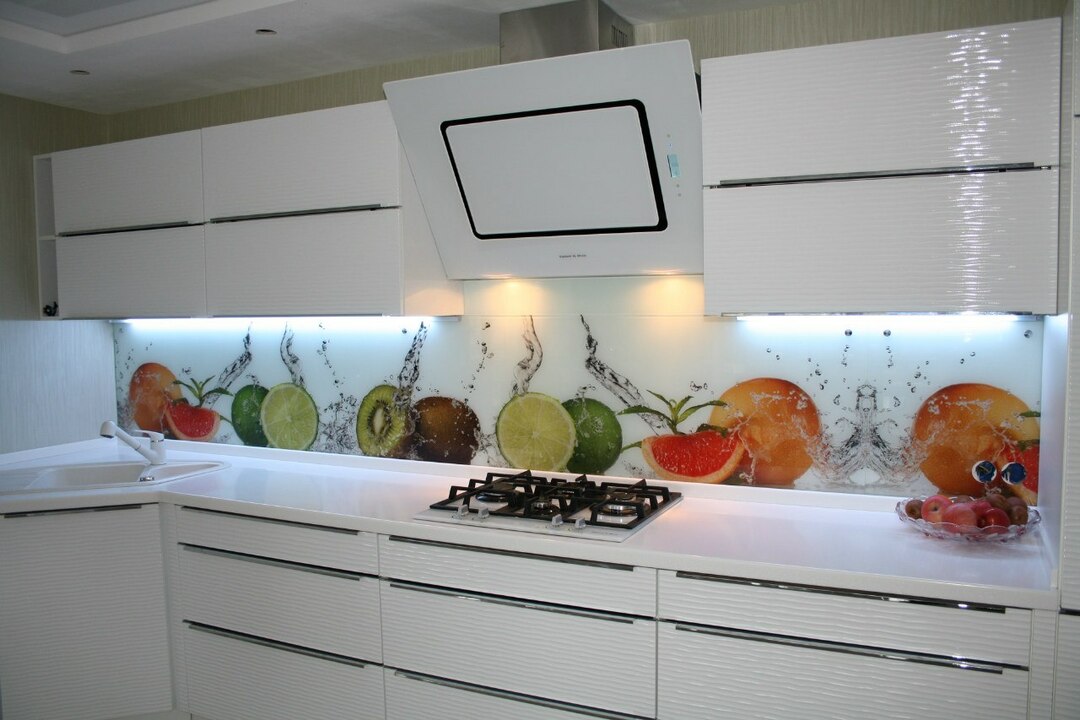
Mirror
The skinal is transformed into a real mirror with the help of silver paint applied to the back of the panel. Reflective elements blur the visual boundaries of the premises, make the rooms brighter.

Film
This option for decorating a glass panel can be attributed to the cheapest. At the first stage, the image is applied to a polymer film with an adhesive base, then the material is fixed on the skin. It is necessary during installation to achieve full adherence of the panel to the wall. Otherwise, moisture and steam will enter the cracks, which will quickly render the film unusable.

Painting
The next option, on the contrary, refers to the most expensive ways to design an apron. The image in this case is applied by a professional artist. Hand painting allows you to create unique images. If you have sufficient artistic skills, try your hand and paint skins with your own hands.

Photo printing
The image for decoration can be selected from the manufacturer's catalog or you can use your own photos. There are two ways to apply photo printing to glass:
- through UV printing;
- using a film.
The first method has significant advantages. It provides:
- high definition and quality of images, protected from smearing and fading;
- environmental friendliness - paints do not have any odors, do not contain toxic elements or impurities, which is required for kitchen decoration;
- durability - high resistance to fading, moisture and high temperatures makes the service life of the panel unlimited.

Skinali with 3D-drawing
An apron with a three-dimensional image can impress anyone. It takes on the role of the main interior accent, which must be set off with a neutral monochromatic background. Such an element can become the semantic center of a kitchen in the spirit of minimalism, contemporary, high-tech, loft and any other modern style, which is characterized by laconicism and elegance.

Backlight options
Comfortable work in the kitchen working area is impossible without high-quality lighting. Skinali as a lighting device is a spectacular and extraordinary solution. In fact, the light is emitted by a hidden LED strip that allows you to illuminate the image, help it stand out in a dark room. How the skinned will look depends on the location of this ribbon.
- Rear mounting. In this case, the light strip is mounted behind the glass, slightly moved away from the wall. It is an excellent choice for lacquered panels or mirrored surfaces. For glasses decorated with film or painting, this method will not work. The resulting gaps will open access to an aggressive environment that is destructive for them.
- End mounting. The tape is attached to the upper and lower border of the canvas, which is fixed against the wall. In this case, it turns out to more effectively illuminate both the drawing itself and the kitchen as a whole. In addition, the back of the skin becomes maximally protected from the destructive effects of steam and chemicals.
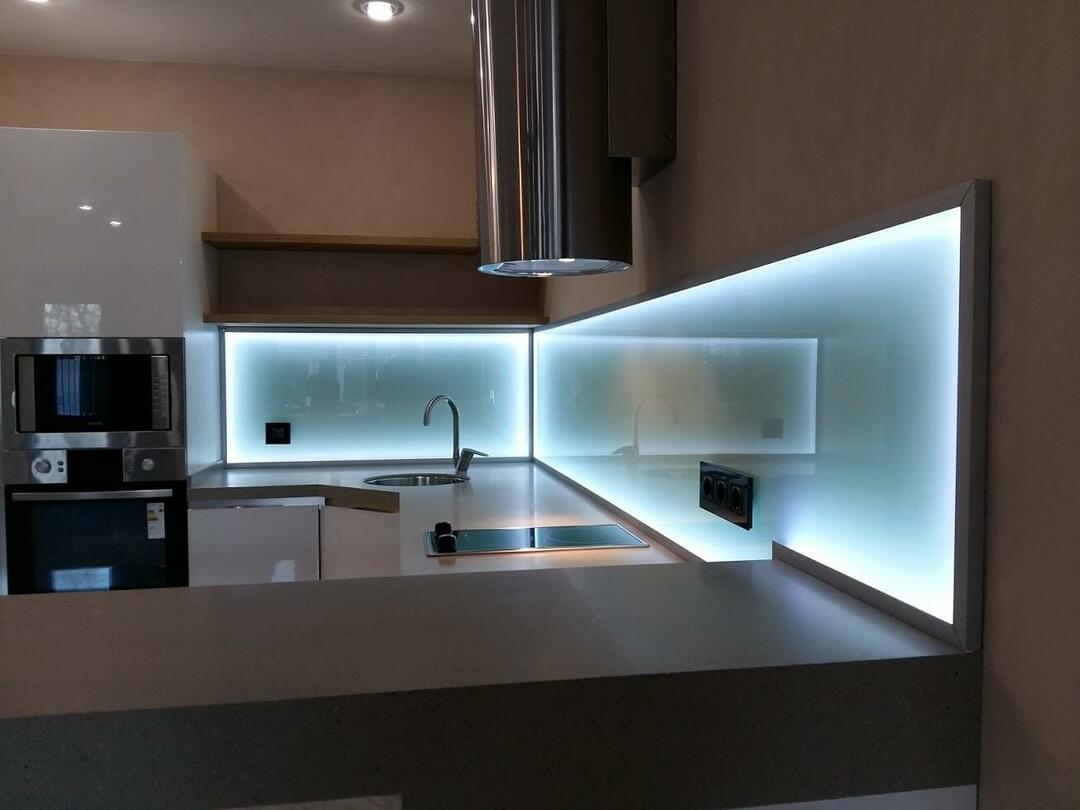
Base material
A base made of a wide variety of materials is suitable for installing a glass screen:
- concrete;
- wooden;
- brick;
- aerated concrete
- plasterboard;
- plywood;
- from chipboard.
The main thing is that the wall does not have significant drops and is treated with an antibacterial primer. Skinali can even be mounted on ceramic tiles, if the cladding is even enough. Some base options - such as brickwork or wooden beams, can do without additional decoration. A transparent cloth is enough to protect them. The same screen can be used to close beautiful wallpapers.
The mounting method is selected depending on the characteristics of the base. For example, to fix the panel on drywall, you need to stock up on butterfly dowels.

Installation methods for skins
Screens are mounted above the working area in two ways - using:
- glue;
- special fasteners.
A perfectly flat base is required for the adhesive installation. Mounting with fasteners is not so demanding. However, differences with a height of more than 1 cm are unacceptable. It is necessary to level the area intended for cladding as much as possible. The angle between the walls when joining parts must be exactly 90 degrees.
At the preparatory stage, it is necessary to dismantle the existing switches and sockets, and push the glasses integrated into the wall to a thickness of 6-10 cm. It is better to invite a specialist to do this work.
It is quite problematic to carry large-sized panels through crowded aisles. Therefore, furniture and other obstacles should be removed from the path in advance. The apron should be delivered with the utmost care.

Glue
It is allowed to use liquid nails for mounting the apron only if a flat, high-quality plastered and completely dried wall acts as a base. The surface should be free of dust, dirt and drops.
The technology for attaching the apron to the glue is not particularly difficult. The main thing is to carefully align all the fragments during the installation process and carefully combine the joints. Leaving large gaps between the apron and headset elements should be avoided. The joints on the outside must be coated with silicone sealant. The product should be applied in a neat, inconspicuous layer. In this case, it will not spoil the appearance of expensive finishes, and at the same time, it will protect the wall from the formation of fungus.
The adhesive is evenly distributed over the surface of the board. The biggest challenge is that it needs to be applied along the way. First, the skins are placed on the tabletop and the dimensions are checked for correctness. After that, the panel is deflected at a small angle and glue is applied practically by weight. Then the panel is pressed to the base for a few minutes and left to dry completely. Adhesive installation is not particularly difficult, but requires a safety net and the help of at least one person. The screen has an impressive weight. During fastening, it is necessary to exclude the possibility of material sliding along the wall and accidental damage. When installing an apron for a corner kitchen, it is necessary to carefully align the joints.

Fixing
It is not necessary to carefully prepare and level the surface to mount the panel to walk-through or pendant mounts. With this method, minor irregularities in the base will not play a role. The main thing is to securely fix the skinned on the base. This will make it possible to successfully operate it for several decades.
The first step is to ensure the safety of the installation process. The network is de-energized and the sockets and switches are dismantled.
Mounting on feed-through fasteners
If the apron is intended to be fixed with through-type fasteners, technological holes will be made in the corners of it. We try on an apron and outline the places where the dowels need to be installed.
For the fitting and installation of glass sheets for any installation method, it is advisable to use special vacuum suction cups. This allows you to maximize the safety of the workflow, make it more comfortable and less laborious.
After trying on, holes are drilled in the wall into which the embedded parts of the fasteners are installed. Next, you need to attach the panel to the section of the wall to be faced and fix it with dowel-nails. We decorate unaesthetic hats with camouflage caps.
In the holes made by the manufacturer, sockets and switches are installed. If the distance from the front surface to the wall does not allow you to securely fix the outlet, you can put wooden planks and fix the product with self-tapping screws. For fixing the planks themselves, it is better to use dowels.
Attachment to hinged fasteners
Plates and clamps made of metal are used as hinges. They are fixed to the wall with dowels and look quite aesthetically pleasing. However, with this method, "pulling" the apron close to the wall will not work. Therefore, the formation of a small gap around the perimeter of the canvas cannot be avoided.
Installation work is carried out in accordance with the following algorithm:
- the initial fitting of the panel is made;
- fasteners are mounted;
- the wall panel is fixed;
- sockets are installed.

Correct size calculation
Careful measurements must be taken to ensure that the custom-made panel fits exactly on the intended wall section. It is necessary to accurately measure the dimensions of the future panel, its thickness, the location of the sockets and hooks. It is required to take into account whether the canvas will start behind the working surface and boxes of the upper tier. A 20 mm margin is usually sufficient. Otherwise, costly product adjustments may be required.
For which interiors is suitable
One of the basic design rules is that you should not combine more than 3 colors at the same time in the design of one room. Therefore, when choosing a decorative component of the skin, the existing interior should be taken into account. Shades, as well as images, should not argue with the chosen style of the kitchen. Agree - in the realm of natural materials, an image of outer space or the sparkling lights of a night metropolis will look strange. Bright and juicy images of berries or tropical fruits will fit perfectly into the interior, saturated with plastic and spectacular tiles.
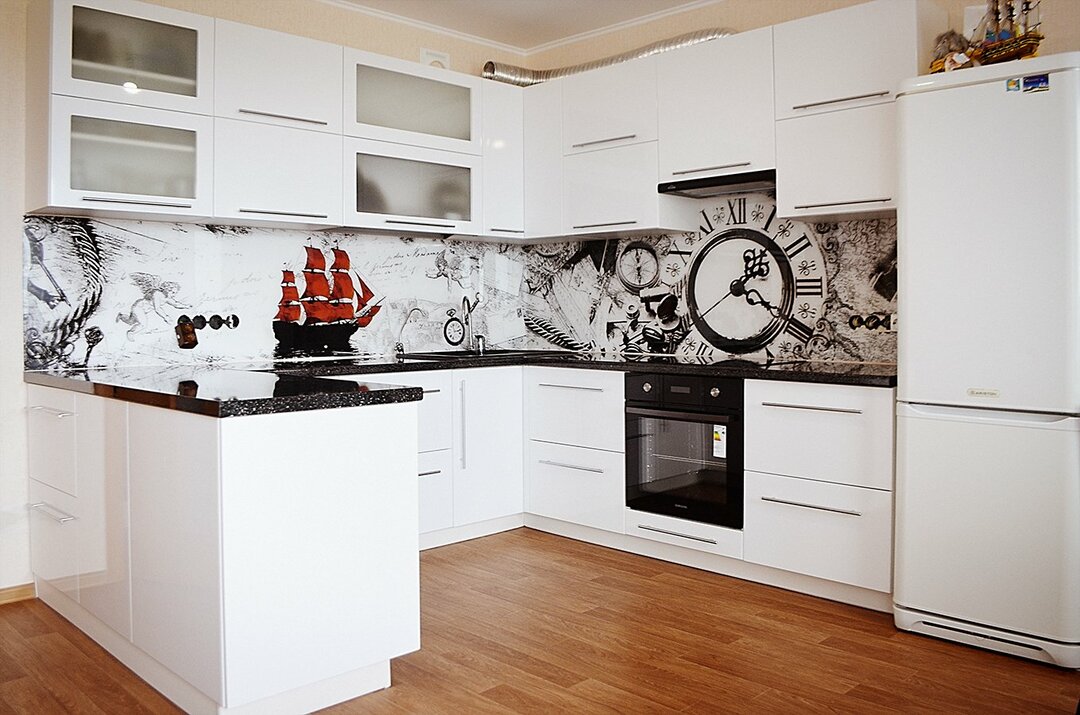

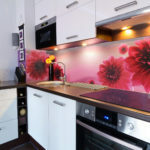



How to choose and order skinals for your kitchen
After studying the varieties of skinals, you can start choosing a specific product. Best of all, products made by the same manufacturer from whom the kitchen set itself was ordered will fit into the interior. However, not all companies can provide this service.
If the panel is ordered from an unverified supplier, do not be lazy to read the reviews of his real customers. Information can be found on various forums, social networks.
We do not recommend chasing a meager price or promotional items. It may very well be that such conditions are a way to sell low-quality goods. Do not forget to inspect the brought panel for chips, scratches. Rate the image quality.

Care and maintenance tips
Every glass apron owner wants the product to retain its original colors and gloss for years to come. And this is unlikely to be accomplished without proper care. Of course, glass is a durable material and is not as susceptible to external influences as natural stone or wood. Nevertheless, you should follow the recommendations for its correct operation:
- to remove dust from glass surfaces, use a damp microfiber cloth or soft cloth;
- cleaning the surface from grease stains and other contaminants should be done without the use of aggressive or abrasive agents. Conventional dishwashing detergent works much more gently;
- to add shine, polish the skins with any window cleaning sprays;
- removing lime deposits, which can often be observed in the area of \ u200b \ u200bthe sink, can be removed using a weakly concentrated acidic composition;
- it is advisable to use the distant burners adjacent to the glass to a minimum;
- be extremely careful when working with sharp and heavy objects, household appliances. Otherwise, chips and scratches on the surface of the apron cannot be avoided.

Conclusion
If you have not yet decided on the choice of skin for the kitchen, we suggest going on an exciting journey through the photo catalog below. Perhaps a selection of beautiful and extraordinary glass aprons will inspire you to create an original product.



